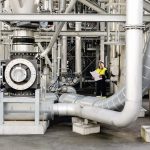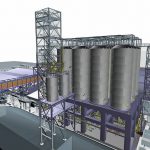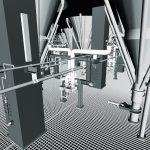The German company Zeppelin Systems is used to adapting itself to the changing conditions in the international markets of the plastics industry. Those changes, however, now occur much more frequently than ever before. In order to maintain control over costs and time, plant engineering companies have to adjust too. In the future, the focus will be on developing innovative – for example, increasingly digital – processes, not only for planning but also for components which communicate in a digital network.
Innovative plant design for efficient dosing and feeding processes
With value engineering and 3D laser scanning
The German company Zeppelin Systems is used to adapting itself to the changing conditions in the international markets of the plastics industry. Those changes, however, now occur much more frequently than ever before. In order to maintain control over costs and time, plant engineering companies have to adjust too. In the future, the focus will be on developing innovative – for example, increasingly digital – processes, not only for planning but also for components which communicate in a digital network.
Twenty years ago, plant engineering in the plastics producing and manufacturing industries had a lead time of four weeks until the start of a project. Today, the first planning results have to be available within this deadline. The time between an investment decision and commissioning is less than half of what it was only a few years ago. As a result of this, the entire planning process has to be faster and more efficient.
There are quite a few ways to significantly reduce the time to market, especially when it comes to planning and designing plants for the plastics industry. Zeppelin Systems, as a long-time material handling specialist, ensures that raw material is reliably discharged from reactors, processed, then transported to the extruder and finally to the packaging plant. A component failure in the internal logistics or an interface flaw will disrupt the overall process. This is why plant engineering companies now focus on the engineering as a whole and not just on individual components such as rotary feeders or dosing units.
The logical consequence is that Zeppelin adopts the same kind of strategy for planning as an architect. Its engineers provide customers with unbiased advice and develop their ideas into a functional concept. For example, various dosing and weighing units can be used to feed material into an extruder: one does the job faster and another more accurately, while the next has a higher throughput and the fourth probably requires fewer software changes to adapt to the existing dosing unit. Zeppelin advises the customer on the best possible solution and makes sure all components fit together perfectly. The customer profits doubly: there is a wider variety of products to choose from and the overall process is optimised.
Tools for efficient planning
Whereas traditional machine builders focus on the machine, plant engineering companies plan with the complete plant in mind. Zeppelin Systems has developed a value engineering concept for this purpose. Since it starts at an early stage of the development phase, all relevant data required for optimal decision-making is available in good time, enabling a detailed discussion and optimisation of the plant concept in a digital model. This results in higher quality solutions, for instance with more efficient piping, an improved room layout, perfect positioning of all components and shorter distances. The model review often takes place during the contract procedure – when very little scope for optimising the concept remains. Zeppelin Systems no longer uses a sequential planning process for this reason. Instead, many planning steps are now performed in parallel, leading to considerable time savings.
With the help of various tools available to Zeppelin Systems, potential cost and time economies can also be identified within individual process steps. The plant’s technical specifications are drawn up using front end engineering design (FEED). This phase is crucial for the efficiency of the plant, as about 80 % of the total costs for planning, construction and operation are determined here. The result is a concept with all quantities, dimensions, parameters and processes that allows sufficient freedom to optimise the plant further. The main components are integrated in an overall layout plan at this stage. The planning basis is then established and the plant undergoes an optimisation phase during the first dry run, as it were.
Accurate picture of the as-built condition
The planning process for existing plants can now also be performed more precisely and more efficiently. Unlike with newly built plants, usable documentation is often not available. And even if such documents do exist, they tend to be inaccurate or they fail to consider adjustments during the construction phase or to reflect other changes made while the plant was operating. Furthermore, evaluating these documents is both time-consuming and expensive. This is why document reviews are rarely performed during the plant modification planning phase or the existing plant is measured again, often with dire consequences. With complex plants, the chances that no mistakes at all will be made are very slim.
The planning process for highly complex existing buildings can easily be improved with the help of innovative tools such as laser scanners, which create an accurate model of the plant. The complete plant is scanned point by point (so-called point cloud) with a 3D laser scanner, so that the entire plant is on file and the planners get a very detailed and up-to-date 3D image. The precision offered by this method is amazing, namely 1 to 2 mm.
Photographs can also be taken of the plant or specific parts of it. The scans are then combined in the point cloud and converted by the software into a photorealistic model. Laser scanning is not only faster than traditional alternatives, it also displays all details and captures the complete plant. The planner ends up with a comprehensive and up-to-the-minute 3D image. In order to utilise the data, however, it must be exported from the point cloud and imported into the planning tool.
The planner can then identify functional units and extract them from the overall plan. Only then can a decision be taken regarding the components that will remain in the old plant and those that will be disassembled during the modernisation work. Informed decisions are likewise possible on component priorities in case of conflicts of objectives or clashes. Thanks to this 3D model of the steel structure, all components and the piping, possible ways to optimise the plant can be elaborated quickly and reliably, for example by making it more easily accessible for maintenance and servicing or by improving the use of space. Plant conversions can therefore be planned accurately and carried out with less downtime and a higher level of safety.
Zeppelin has invested a lot in the coordination of the various planning systems. Planning departments now work exclusively with point clouds rather than vector-based images as in conventional CAD systems, this being the only way to produce an intelligent model from a raw scan. This model depicts a fully integrated plant extension with no interface problems, as little intrusion in the existing plant as possible and no component clashes or costly reconstruction measures during the installation process.
Hall 9, Booth B41
www.cpp-net.com search: cpp0316zeppelin
Rochus Hofmann
Rochus Hofmann
Managing Director,Zeppelin Systems
Share:









